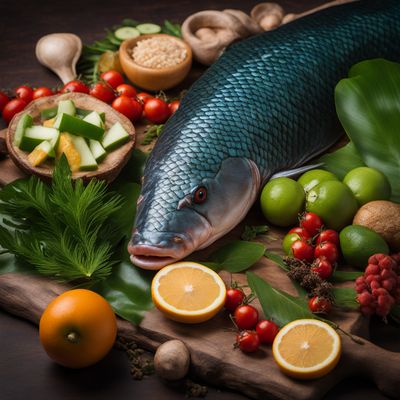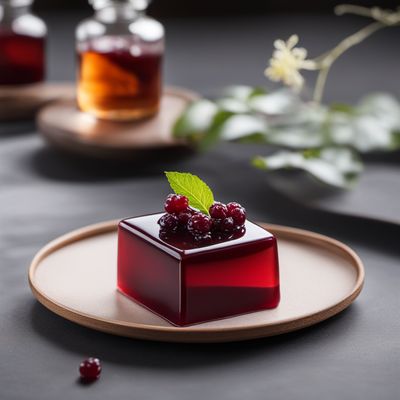
Ingredient
White crappie
The Delicate Delight: Exploring White Crappie
White crappie is a small to medium-sized fish with a silvery-white body and dark speckles or vertical bars along its sides. It has a deep, compressed body shape and a slightly concave forehead. The flesh of white crappie is tender and flaky, with a mild and slightly sweet flavor. When cooked, the meat turns white and has a delicate texture. This fish is often pan-fried, grilled, or used in fish stews and soups.
Origins and history
White crappie is native to North America and is commonly found in freshwater lakes, rivers, and reservoirs across the continent. It is particularly abundant in the eastern and central regions of the United States. White crappie has been a popular game fish for recreational anglers, known for its willingness to bite and its delicious taste. It has also become a popular choice for commercial fishing and aquaculture due to its culinary appeal.
Nutritional information
White crappie is a good source of lean protein and essential nutrients. It is low in calories and fat, making it a healthy choice for those looking to maintain a balanced diet. This fish is also rich in omega-3 fatty acids, which are beneficial for heart health and brain function. It provides minerals like phosphorus and selenium, as well as vitamins B12 and D. However, it is important to note that the nutritional content may vary depending on the size and preparation method of the fish.
Allergens
Fish
How to select
When selecting white crappie, look for fish that have clear, bright eyes and shiny scales. The flesh should be firm and spring back when pressed gently. Avoid fish that have a strong fishy odor or appear slimy. If purchasing from a fish market or grocery store, ask for the fish to be cleaned and scaled. Fresh white crappie should be stored in the refrigerator and consumed within 1-2 days to ensure optimal freshness and flavor.
Storage recommendations
To maintain the freshness and quality of white crappie, it is best to store the fish on ice or in a cooler immediately after catching or purchasing. Keep the fish refrigerated and consume it within 1-2 days. If you need to store it for a longer period, you can freeze white crappie by wrapping it tightly in plastic wrap or placing it in a freezer bag. Properly stored, frozen white crappie can last for up to 3-4 months. Thaw frozen fish in the refrigerator overnight before cooking.
How to produce
White crappie is primarily caught through recreational fishing or commercial fishing methods. It can also be raised in aquaculture systems, where the fish are bred and grown in controlled environments. However, producing white crappie on a small scale may require specialized equipment and knowledge. It is advisable to consult local fisheries or aquaculture experts for guidance on producing white crappie.
Preparation tips
White crappie can be prepared in various ways, depending on personal preference and culinary traditions. It is commonly pan-fried or grilled, allowing the delicate flavor and texture to shine. The fish can be seasoned with herbs, spices, or a simple marinade to enhance its natural taste. White crappie is also a popular choice for fish stews, soups, or chowders, where it adds a subtle sweetness and flaky texture. It pairs well with citrus flavors, garlic, and fresh herbs. When cooking white crappie, be careful not to overcook it, as it can become dry and lose its tenderness.
Culinary uses
White crappie is commonly used in various dishes and cuisines. It can be the star of a seafood dinner, served alongside vegetables and grains. White crappie fillets can be used in tacos, sandwiches, or fish cakes. The fish is also a popular choice for fish fries or fish and chips. In addition, white crappie can be added to salads, pasta dishes, or stir-fries to provide a protein-rich element. Its delicate flavor and texture make it a versatile ingredient that can be enjoyed in numerous ways.
Availability
North America
More ingredients from this category » Browse all

Snakeheads(=Murrels)
The Mighty Murrels

Nile perch
The Mighty Fish of the Nile: Unveiling the Secrets of Nile Perch

Catfishes (freshwater)
The Delicate Delight: Freshwater Catfish

Largemouth black bass
The Prized Catch: Largemouth Black Bass

Bluegill sunfish, or bluegill bream
The Freshwater Delight: Bluegill Sunfish

Perch
Delicate Perch: A Freshwater Gem

Characins
The Diverse World of Characins: Exploring the Beauty and Variety of These Tropical Fish

Climbing perch
The Aquatic Acrobat: Exploring the World of Climbing Perch

Gourami (asia)
The Delicate Delight of Gourami

Pike
The Mighty Predator of Freshwater

Asian swamp eel
The Aquatic Delicacy: Unveiling the Asian Swamp Eel

Arapaima
The Mighty Arapaima: A Culinary Treasure from the Amazon
Recipes using White crappie » Browse all

Oeufs en Gelée with a Twist
Egg Delight: A Modern Twist on Oeufs en Gelée

Congolese Fraisier
Tropical Delight: Congolese Fraisier with a Twist

Debessmanna - Latvian Honey Cream Dessert
Heavenly Honey Delight: A Sweet Indulgence from Latvia

Hong Kong-style Seafood Hot Pot
Savory Seafood Delight: Hong Kong-style Seafood Hot Pot

Soulful Southern Whitebait Fritters
Savory Soulful Delight: Southern Whitebait Fritters

Kodava-style Gelatinous Meat Dish
Savory Meat Delight: A Kodava Twist on Gelatinous Delicacy

Chinese American Style Red Bean Jelly
Sweet and Silky Red Bean Delight

Crispy Spiced Crappie Delight
Zesty Crispy Crappie: A South American Delight

German Presskopf with a Twist
Savory Delight: Reinvented German Presskopf

Creamy Vanilla Panna Cotta
Velvety Delight: Creamy Vanilla Panna Cotta

Sudanese Coconut Pudding
Exotic Sudanese Delight: Coconut Pudding with a Sudanese Twist

Friture de la Moselle
Crispy Delights from the Moselle River